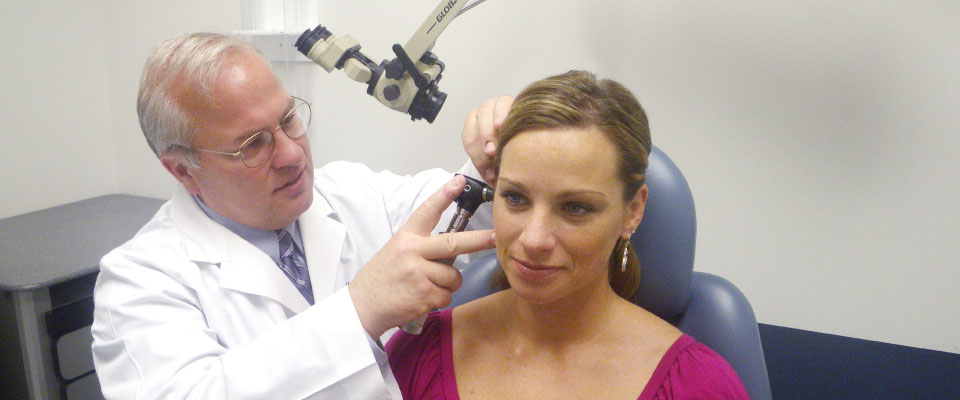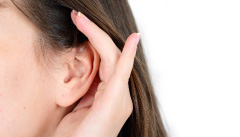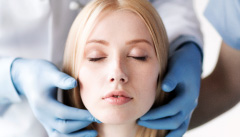Sensorineural Hearing Loss (SNHL)
Hearing loss can be broadly separated into two categories: conductive (problems in delivering sound to the inner ear) and sensorineural (problems of the inner ear, or cochlea, and/or the auditory nerve that connects the inner ear to the brain). Sensorineural hearing loss (SNHL) happens when there is damage to tiny hair cells in the cochlear and/or the auditory nerve. In children, the most common causes of SNHL include inner ear abnormalities, genetic variations, jaundice (or a yellowing of the skin or whites of the eyes), and viral infection from the mother during pregnancy. In adults, SNHL is most commonly caused by aging, exposure to loud noises, head trauma, or other conditions (see below for more detail).
What Are the Symptoms of SNHL?
Symptoms of SNHL may include:
- Muffled hearing
- Difficulty understanding speech
- Sudden or steady loss of hearing
- Full or “stuffy” sensation in the ear
- Ringing in the ear
- Dizziness
What Causes SNHL?
SNHL happens when there is damage to tiny hair cells in the cochlear and/or the auditory nerve. Sound energy reaches the cochlea, but damaged hair cells are unable to convert sound waves into neural signals that pass through the auditory nerve to the brain. Auditory nerve abnormalities will also cause SNHL. Other causes may include:
- Sudden hearing loss—caused by a virus; you should see an ENT (ear, nose, and throat) specialist, or otolaryngologist, for urgent treatment that could help recover some hearing
- Aging—gradual SNHL that cannot be reversed (most common)
- Acoustic trauma—exposure to loud noises (e.g., industrial/machinery or explosion/gunfire close to the ear; can be prevented with proper protection)
- Head trauma or abrupt changes in air pressure—this can cause the space that contains inner ear fluid to rupture
- Autoimmune inner ear disease—the body’s immune system attacks the inner ear and causes progressive hearing loss in both ears
- Ménière’s disease—a condition characterized by fluctuating hearing loss, dizziness, ear fullness, or ringing in the ears (called tinnitus)
- Central nervous disease—damage caused by a condition such as multiple sclerosis
- Cochlear otosclerosis—abnormal bone growth in the inner ear
- Congenital inner ear malformation—genetic or environmental abnormalities (very common cause in children)
- Benign tumor—called “vestibular schwannoma,” this is a noncancerous tumor on the adjacent balance nerve that compresses the hearing nerve that connects the inner ear to the brain, causing SNHL
What Are the Treatment Options?
If you are experiencing hearing loss, you should see an ENT specialist who can make the correct diagnosis. This is important because the treatment for hearing loss depends on the cause. Once a diagnosis is made, your physician will be able to talk to you about all treatment options. A critical part of the evaluation will be a hearing test (audiogram) performed by an audiologist to determine the severity of your hearing loss, as well as whether it is conductive, sensorineural, or a combination of both.
Your ENT specialist may recommend specific treatment options based on the results of your hearing test, or other potential tests such as a CT or MRI imaging scan. Treatment options can include:
- Continuing observation with repeated hearing tests
- Medical therapy—corticosteroids (oral or injection through the eardrum) may be used to reduce cochlear hair cell swelling and inflammation after exposure to loud noises; diuretics may be used for Ménière’s disease
- Low-sodium diet
- Evaluation and fitting of a hearing aid(s) or other assistive listening devices
- Preferential seating in class for school children
- Surgery to correct the cause of the hearing loss
- Surgery to implant a hearing device
SNHL can be treated with the use of conventional hearing aids or an implantable hearing device. Again, your ENT specialist and/or audiologist can help you decide which device may work best for you depending on your hearing test results and your lifestyle.
What Questions Should I Ask My Doctor?
- What is the cause of my hearing loss?
- Will my hearing loss likely get worse with time?
- What are my treatment options?
- What are the risks of the surgery you are recommending?
- Do you do this surgery frequently?
Rhinitis
Rhinitis is a condition that typically involves nasal obstruction or congestion, runny nose or post-nasal drip, itchy nose, and/or sneezing. There are various causes for these symptoms, although they are broadly divided into two types: allergic rhinitis (nasal symptoms related to allergy) and non-allergic rhinitis (nasal symptoms that are not related to allergy).
What Are the Symptoms of Rhinitis?
Symptoms of rhinitis may include:
- Nasal blockage or congestion
- Sneezing
- Runny nose or postnasal drainage
- Itchy nose
Rhinitis may occur before a case of sinusitis or with sinusitis, a condition where infection or inflammation affects the sinuses. If you have facial pressure, decreased sense of smell, or a greenish-yellow nasal drainage, you may also have sinusitis. A qualified ENT (ear, nose, and throat) specialist, or otolaryngologist, can provide a thorough evaluation and appropriate treatment for your nasal/sinus condition.
What Causes Rhinitis?
Allergic rhinitis occurs when your body’s immune system over-responds to specific, non-infectious particles such as plant pollens, molds, dust mites, animal proteins, chemicals, foods, medicines, insect venom, and other triggers. During an allergic attack, a special antibody (fighting protein), called IgE, attaches to cells that release histamine and other chemicals in the lungs, skin, and the mucous linings of the body. These chemicals open the blood vessels and produce skin redness and swollen membranes. When this happens in the nose, sneezing, itching, runny nose, and congestion occur.
Seasonal allergic rhinitis depends on specific plants that are pollenating at that time. In the United States, springtime allergic rhinitis is typically due to pollinating trees. Early summer allergic rhinitis is often due to grass pollination, and allergic rhinitis in the fall is usually due to weeds pollinating. Hypersensitivity to ragweed is very common in autumn. Also in the fall, you may experience allergic symptoms from mold spores on falling leaves.
Perennial allergic rhinitis can be felt year-round and can result from sensitivity to animal proteins, mold, houseplants, and dust mites in carpeting and upholstery. When seeking a medical evaluation for suspected allergic rhinitis, it is important to be aware of the pattern of symptoms (seasonal triggers, indoor vs. outdoor, specific triggers, animal exposure, etc.).
Non-allergic rhinitis and vasomotor rhinitis (a type of non-allergic rhinitis) do not depend on the presence of IgE antibodies, and is not due to an allergic reaction. You can have non-allergic rhinitis even if you test positive for allergies. Some of the causes of non-allergic rhinitis include:
- Certain infections
- Certain medications (various over-the-counter and prescription preparations)
- Eating and drinking (sometimes specific foods, sometimes all food/drink consumption)
- Weather or temperature changes
- Aging
- Hormonal changes or pregnancy
- Consumption of alcohol, especially red wine
- Inflammation or irritation in the nose unrelated to allergy
- Nasal symptoms of other medical conditions
Are There Related Factors and Conditions?
Depending on the type of rhinitis, certain conditions may be associated, such as:
- Asthma
- Acute sinusitis
- Inflammation of the eye (conjunctivitis)
- Atopic dermatitis or eczema
- Poor ventilation of the ears (or eustachian tube dysfunction)
- Laryngitis (inflammation causing hoarseness of voice)
- Eosinophilic esophagitis
- Sleep disturbance
What Are the Treatment Options?
Treating rhinitis depends on the specific cause or diagnosis. If there is a specific trigger that can be avoided, this may be a successful treatment. For example, in people with cat allergy, avoidance of cat exposure and direct contact with cats may help to control symptoms.
Often, medications are used to control symptoms. Depending on the specific cause of the rhinitis symptoms, some of the medications that may be used include:
- Intranasal saline spray or rinse
- Antihistamines (oral or intranasal)
- Corticosteroids (usually applied as an intranasal spray)
- Ipratropium bromide intranasal spray
For allergic rhinitis, allergen immunotherapy may be an option. This is most commonly provided via allergy shots or tablets or liquid drops taken under the tongue. Again, a qualified ENT specialist or allergist should assess your situation to determine whether allergen immunotherapy is an option.
For severe runny nose or nasal obstruction/congestion that does not respond to medications, your ENT specialist may consider additional office procedures or surgery appropriate to your situation.
What Questions Should I Ask My Doctor?
- What is the most likely cause of my rhinitis symptoms?
- Is allergy testing a consideration in my case?
- Will avoiding certain triggers help to improve my symptoms?
- Which medications are best suited to treat my condition?
- Are any additional evaluations necessary? Lab tests? Consultations with other specialists?
Post-Nasal Drip
Glands in your nose and throat continually produce mucus, normally one to two quarts per day. Mucus moistens and cleans the nasal lining, moistens air, traps and clears what is inhaled, and helps fight infection. Mucus is normally swallowed unconsciously, but when there is a feeling of the mucus gathering in the throat or dripping from the back of your nose, it is called post-nasal drip.
What Are the Symptoms of Post-nasal Drip?
Symptoms of post-nasal drip can include:
- Feeling of mucus drainage into the throat
- Frequent swallowing
- Throat clearing
- Raspy or gurgling speech
- Sore irritated throat
- Feeling a lump in the throat
In children, thick or foul-smelling secretions from one side of the nose can mean that something is stuck in the nose such as a bean, wadded paper, or piece of a toy. If these symptoms are observed, seek a physician for examination.
Post-nasal drip often leads to a sore, irritated throat. Although there is usually no infection, the tonsils and other tissues in the throat may swell. This can cause discomfort or a feeling that there is a lump in the throat. Successful treatment of the post-nasal drip will usually clear up these throat symptoms.
What Causes Post-nasal Drip?
Causes of post-nasal drip can include:
- Bacterial infections
- Allergies
- Vasomotor rhinitis (overly sensitive nose)
- Medications that thicken mucus
- Gastroesophageal reflux
- Age
Thin clear secretions can be due to colds and flu, allergies, cold temperatures, bright lights, certain foods or spices, pregnancy, and other hormonal changes. Various drugs (including birth control pills and high blood pressure medications) and irregular nose cartilage can also produce increased mucus.
Thick secretions in winter often result from dryness in heated spaces. They can also come from sinus or nose infections and allergies, especially to foods such as dairy products. If thin secretions become thick, and turn green or yellow, it is possible that a bacterial sinus infection is developing.
What Are the Treatment Options?
Diagnosing post-nasal drip may include a detailed ear, nose, and throat exam, endoscopy (using a camera to look inside the nose and throat), or X-rays. Post-nasal drip can be difficult to cure, and treatment varies according to the cause:
- Bacterial infections are usually treated with antibiotics, nasal spray, decongestants, and nasal saline irrigations. For chronic sinusitis, surgery to open the blocked sinuses may be required.
- Allergies are best managed by avoiding the causes. Antihistamines, decongestants, cromolyn and steroid nasal sprays, or oral steroids may offer relief. Some older, sedating antihistamines may dry and thicken post-nasal secretions more; newer non-drowsy antihistamines do not have this effect. Immunotherapy (desensitization) using allergy shots or drops under the tongue may help. Talk to your doctor before starting any of these medications.
- Gastroesophageal reflux treatment includes elevating the head of the bed six to eight inches, avoiding food and beverages for at least three hours before bedtime, weight loss, and eliminating alcohol and caffeine from the diet. Antacids such as TUMS®, Mylanta®, and Gaviscon®, or acid blockers such as Zantac® or Pepcid® also provide benefit. If the reflux does not get better, you should see your primary care provider, or an ENT (ear, nose, and throat) specialist, or otolaryngologist.
- Measures that allow mucus secretions to pass more easily may be recommended. Many people, especially older persons, need more fluids to thin out secretions. Drinking more water, eliminating caffeine, and if possible avoiding diuretics (medications that remove fluid from the body by increasing urination) will help. Mucous-thinning agents such as guaifenesin (Mucinex®, Robitussin®) make secretions thinner. Saline nasal irrigations alleviate thickened secretions. Nonprescription saline nasal spray (Ocean®, Ayr®) is a natural way to moisten the nose.
Related Conditions
Several other conditions may feel like post-nasal drip but are swallowing problems caused by a backup of solids or liquids in the throat. Conditions that may be related to post-nasal drip include:
- Sinus conditions
- Rhinitis
- Gastroesophageal reflux disease
- Allergies
What Questions Should I Ask My Doctor?
- What is the cause of my post-nasal drip?
- Are there any changes in my symptoms that I should be watching out for?
- Are there serious complications that could develop?
Pediatric Thyroid Cancer
The thyroid is a butterfly-shaped gland located at the base of the throat. It has two lobes joined in the middle by a strip of tissue (the isthmus). The thyroid secretes three main hormones that control the body’s energy and growth: Thyroxine that contains iodine needed for growth and metabolism; Triiodothyronine that also contains iodine and similar in function to Thyroxine; and Calcitonin that decreases the concentration of calcium in the blood and increases calcium in the bones. All three of these hormones have an important role in your child’s growth.
Thyroid nodules are uncommon in childhood, and thyroid cancer is uncommon in children. Still, it is the most common endocrine malignancy in children. It occurs four times more often in females than males, and has similar characteristics as adult thyroid cancer. Surgery is the preferred treatment for this cancer. Although the procedure is typically uncomplicated, risks of thyroid surgery include vocal cord paralysis and low blood calcium (hypocalcemia). An ENT (ear, nose, throat) specialist, or otolaryngologist, or a head and neck surgeon who is experienced with head and neck issues, should be consulted.
What Are the Symptoms of Pediatric Thyroid Cancer?
Symptoms of this disease vary. Your child may experience:
- A lump in the neck
- Persistent swollen lymph nodes
- A tight or full feeling in the neck
- Trouble with breathing or swallowing
- Hoarseness
If any of these symptoms occur, consult your child's physician for an evaluation. The evaluation should consist of a head and neck examination to determine if unusual lumps are present. A blood test may be ordered to determine how the thyroid is functioning. Ultrasonography uses sound waves to create an image of the thyroid gland and neck contents such as lymph nodes.
Other tests that may be warranted include a radioactive iodine scan, which provides information about the thyroid shape and function and identifies areas in the thyroid that do not absorb iodine in the normal way, or a fine needle biopsy of any abnormal lump in the thyroid or neck. Also called fine needle aspiration (FNA), a fine needle biopsy is when a needle is inserted into a lump or mass to collect a sample of cells. Sometimes it is necessary to remove a part of the tumor or one of the lobes of the thyroid gland, known as a thyroid lobectomy, for analysis to help establish a diagnosis and plan for management.
What Are the Types of Pediatric Thyroid Cancer?
Papillary—This form of thyroid cancer occurs in cells that produce thyroid hormones containing iodine. This type, the most common form of thyroid cancer in children, grows very slowly. This form can spread to the lymph nodes via lymphatics in the neck and occasionally spreads to more distant sites.
Follicular—This type of thyroid cancer also develops in cells that produce thyroid hormones containing iodine. The disease afflicts a slightly older age group and is less common in children. This type of thyroid cancer is more likely to spread to the neck via blood vessels, causing the cancer to spread to other parts of the body, making the disease more difficult to control.
Medullary—This rare form of thyroid cancer develops in cells that produce calcitonin, a hormone that does not contain iodine. This cancer tends to spread to other parts of the body and constitutes about five- to 10-percent of all thyroid malignancies. Medullary thyroid carcinoma (MTC) in the pediatric population is usually associated with specific inherited genetic conditions, such as multiple endocrine neoplasia type 2 (MEN2).
Anaplastic—This is the fastest growing of the thyroid cancers, with abnormal cells that grow and spread rapidly, especially locally in the neck. This form of cancer is not seen in children.
What Are the Treatment Options?
If the tumor is found to be malignant, then surgery is recommended. Surgery may consist of a partial removal such as lobectomy (half), subtotal thyroidectomy (removal of at least one lobe and up to near-total removal of the thyroid gland), or a total thyroidectomy. In children with papillary or follicular thyroid cancer, total or near-total thyroidectomy is currently the standard of practice, as children typically have more extensive disease when diagnosed and higher rates of spreading. This reduces the risk of recurrence. In children, there is an increased need for repeat surgery when less than a total thyroidectomy is performed. Lymph nodes in the neck may need to be removed as part of the treatment for thyroid cancer if there is suspicion of spread of cancer to the lymph nodes.
Surgery may be followed by radioactive iodine therapy to destroy cancer cells that are left after surgery. Thyroid hormone therapy may need to be administered throughout your child's life to replace normal hormones and slow the growth of any residual cancer cells.
If cancer has spread to other parts of the body, chemotherapy (treatment by chemical substances or drugs) may be given. This therapy interferes with the cancer cell's ability to grow or reproduce. Different groups of drugs work in different ways to fight cancer cells and shrink tumors. Radiation treatment may also be required for treatment of some forms of thyroid cancer.
In general, treatment outcomes for this type of cancer in children tend to be excellent. The best outcomes are seen in teenage girls, papillary type cancer, and tumors localized to the thyroid gland.
What Questions Should I Ask My Doctor?
- What are my child’s particular treatment options?
- What is my child’s prognosis?
- What are the risks?
- Will my child need thyroid medication?
- If one of my children has thyroid cancer, does that mean that my other children are at risk for the same condition?














